The median 401(k) balance for people in their 30s is around $22,100 as of the first quarter of 2024
People in their 30s might not be close to their retirement savings goals yet, but they still have plenty of time to catch up.
On average, Americans believe they’ll need about $1.46 million to retire comfortably, according to Northwestern Mutual’s “2024 Planning and Progress” study. For millennials, most of whom are in their 30s, that number is slightly higher at around $1.6 million.
However, many people in their 30s have saved far less than this.
The median 401(k) balance for individuals in their 30s is approximately $22,100 as of the first quarter of 2024, based on the latest data from Fidelity Investments, one of the nation’s largest 401(k) providers.
Here’s a breakdown of how much Americans have in their 401(k)s by age, according to Fidelity.
To be fair, many Americans are stretching their funds to cover various expenses, which impacts their ability to save more for retirement.
Over a third of people cite the rising cost of living as a hurdle to reaching their retirement goals, according to Fidelity Investments’ “2024 State of Retirement Planning.” Nearly 30% say that paying off credit card debt and unexpected expenses are also barriers.
How to Get Your Retirement Savings on Track in Your 30s
If you’re in your 30s and concerned about your retirement savings, the good news is that you have time to improve your situation.
Instead of only focusing on your account balance, which can be affected by factors like market volatility and will ideally grow over time through compounding, consider your savings rate. This is the percentage of your pre-tax annual income that you save for retirement each year.
Fidelity recommends a savings rate of 15%, which includes your employer’s match if offered. However, you may need to increase that rate if you’re starting in your late 30s compared to earlier years, says Anne Lester, a retirement expert and author of “Your Best Financial Life: Save Smart Now for the Future You Want.”
“If you’re starting at 39, you’ll need to save more aggressively than if you were starting at 32 or earlier,” she tells CNBC Make It.
To that end, if you haven’t saved anything for retirement, Fidelity suggests a savings rate of 18% if you start at age 30 and 23% if you start at age 35.
One strategy to reach that savings rate is through auto-escalation, which allows you to set your retirement contributions to automatically increase by a certain percentage each year. For example, you could automatically increase your savings rate by 2 or 3 percentage points annually until you reach your target rate.
Another way to boost your retirement savings is by setting aside a portion of any financial windfalls you receive, such as raises or tax refunds, Lester says.
“Those raises and refunds are a relatively painless way to start saving for retirement because you’re not giving up anything you already have,” she says.
